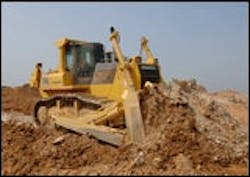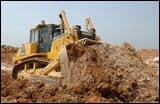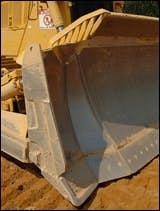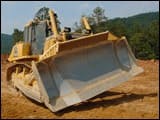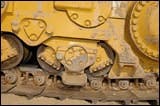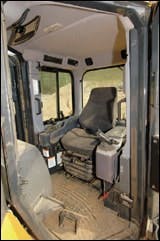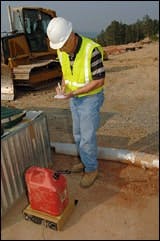Powerful New Crawler Dozer Has Good On-Site Numbers
Although the use of auxiliary tanks is the best way to monitor fuel consumption, the top-off method is effective if carefully done. When the first machine was in position for pre-test fueling (left), we created positioning benchmarks, at the rear of the tracks, which allowed us to subsequently locate each machine in exactly the same spot. We also placed a 5-foot level on the left rear fender and across the back of the tanks (just below the rear window) to establish benchmarks, respectively, for the fore-and-aft and side-to-side attitudes. Initially, the tanks were filled until fuel just covered the bottom of the debris screen.
As we watched Komatsu's brand-new D155AX-6 crawler dozer at work on top of a Georgia mountain, our lasting impression of the machine is the way it sliced cleanly through limestone deposits in its path. Perhaps the new dozer's performance would have been less notable had we not just moments before observed its predecessor model work up a considerable sweat getting though the same spot. We witnessed this rather striking comparison in blade performance while working with Komatsu in late May to evaluate the capabilities and features of the new D155AX-6 crawler dozer ("Dash-6"), compared with those of the machine it replaces, the D155AX-5B ("Dash-5B").
The Dash-6 was introduced just a few months ago, and it's a significantly different tractor than the Dash-5B. Although the primary reason for developing the new model was to comply with Tier-3 emissions regulations, Komatsu took a hard look at the overall design of the Dash-5B and opted to make extensive additional changes in the Dash-6, including an innovative new blade, refined transmission and lock-up torque converter, an undercarriage borrowed from mining-tractor counterparts, plus, a redesigned cab with enhanced electronic controls and instrumentation.
We put one of these newly designed Dash-6 dozers to work — along side a virtually new Dash-5B — at Komatsu's 500-acre training and testing facility in Cartersville, Ga., where the company is developing a new demonstration area. When the new area is completed this fall, Komatsu's site-development contractor, C.A. Murren & Sons, will have moved a million-plus cubic yards of material, most of it a tough mix of red Georgia clay and rock.
In fact, Murren's on-site supervisor, Greg Smith, was kind enough to loan us one of his best dozer operators, Marcos Ballesteros Guillen, for the Dash-6/Dash-5B evaluation. Guillen regularly runs Murren's 525-hp Komatsu D-375A-5 at the site. Our second operator was Komatsu's Gary Svoboda, operator instructor/developer at the Cartersville facility.
Essentially, our in-the-dirt comparison entailed having both Guillen and Svoboda use each machine to open a reasonably large slot trench. Comparing the Dash-6 dozer's production in this exercise with that of the Dash-5B gave us a glimpse into the relative work capabilities of these two dozers. We also monitored fuel consumption during the comparison as means for assessing relative fuel-efficiency between the two.
Komatsu's Kim Karry, product marketing manager, crawler dozers, was instrumental in arranging the evaluation. Our host at the Cartersville facility was senior product manager (demo site and product training), Ed Warner, who, among other responsibilities, is overseeing the demonstration area's development.
Weather for the two-day evaluation had even the natives complaining — with temperatures in the mid-90s and humidity to match. But the days were bright and clear, and we considered the heat and humidity probably a good trade for no rain.
Both test tractors were fitted with a similar variable single-shank, "giant" ripper, but blades differed significantly. The Dash-5B used a semi-U type — 13 feet wide, 5.7 feet high and with a rated capacity of 11.5 cubic yards. The Dash-6, however, was equipped with the newly designed Sigmadozer blade, which Komatsu has developed for its mid-range and large dozers.
The Sigmadozer blade has a cutting edge with a center section that parallels the plane of the blade, but then angles sharply rearward near each end of the blade to intersect with end-wing sections, which again bring the cutting edge forward at an angle. This new 12.3-cubic-yard-capacity blade is 13.25 feet wide, 6.1 feet high and incorporates hydraulically actuated pitch and tilt control.
We staked out four 50-foot-long trench sites and asked Guillen to work one of the machines until the pre-determined trench length was excavated to an approximate depth of 4 feet, with the width being that of the blade. We timed this process until, in his judgment, the trench was of the proper dimensions. Then switching to the other dozer, Guillen duplicated the first trench as closely as possible. We stopped the watch when he indicated that the second trench matched the first. Svoboda then repeated this two-trench process.
We then measured each operator's two trenches in order to calculate the volume excavated. With this figure and the time for excavation, we calculated an hourly production rate for each trench. By averaging the rate for the two Dash-6 trenches, and comparing the result with the averaged production in the Dash-5B trenches, we determined that (in this particular exercise) the Dash-6 exhibited a production advantage of slightly more than 25 percent.
The new tractor also used 13-plus percent less fuel in this exercise. Because each operator excavated basically the same volume of material from each of his two trenches, we concluded that the two dozers did essentially the same amount of work, even though the Dash-5B took longer to do so. Thus, it's fair to say that the Dash-6 exhibited a 13-percent fuel-efficiency advantage, that is, it did as much work as the Dash-5B with 13 percent less fuel.
Thinking through the numbers that resulted from the comparison of these two Komatsu dozers, our first observation is that the new Sigmadozer blade likely was responsible, to a significant degree, for not only the advantage in productivity, but also for the advantage in fuel-efficiency.
The design of the new blade, says Komatsu, reduces cutting resistance and rolls material more effectively. But in concert with these characteristics, according to the company, the new blade also redirects material flow toward its center, resulting not only in larger loads, but also in considerably less windrowing off the sides. The Dash-6 also uses larger push arms, which permit using just one strut (on the right side) with the Sigmadozer blade, a design that brings the blade closer to the tractor nose for enhanced digging forces.
We would guess that the new blade's lowered cutting resistance and enhanced digging forces are notable contributors to the fuel-efficiency advantage noted for the Dash-6. But the Dash-6's new engine, certainly, is also a prime contributor to its observed fuel efficiency.
The new Komatsu "ecot" (ecology and economy technology) SAA6D140E-5 engine, with 10 more net horsepower than the Tier-2 version of the engine in the Dash-5B (320 versus 310), is equipped with cooled-EGR, common-rail fuel injection, charge-air cooling and new electronic controls. (The net-horsepower difference is predicated on the machines' hydraulic fans running at full speed.) Difficult to quantify, however, is the contribution to better fuel-efficiency made by the Dash-6's new Tier-3 engine and that made by its Sigmadozer blade, which is not available for the Dash-5B.
Of course, even if running both tractors with the Sigmadozer blade had been possible, we'd still be left wondering how much the Dash-6's new transmission and lock-up torque converter contributed to the new model's overall better fuel-efficiency. The new transmission provides both a manual and an automatic mode. In the automatic mode, it makes shifts based on electronic information received by communicating with controllers for the engine and for the steering and hydraulic systems. The net result, says Komatsu, is that gear changes are timed to keep the power train operating continuously at maximum efficiency.
In addition, the new lock-up feature in the torque converter is activated when the transmission is in either its automatic or manual mode. Automatic lockup occurs in the normal dozing speed range and, according to Komatsu, this feature eliminates the horsepower loss and the generated heat of the conventional "open" torque converter.
Backing up the higher forces at the Dash-6's cutting edge is a more robust undercarriage. The track frames are thicker and incorporate an added bottom roller (seven, versus six for the Dash-5B). Overall, the undercarriage gauge is wider (by an inch) and places 3 inches more track-on-ground than does the Dash-5B.
Perhaps the most significant undercarriage change is switching the "X-type" bottom-roller bogies in the Dash-5B to "K-type" bogies in the Dash-6. The bogies for both machines are a two-roller assembly mounted in an oscillating frame. The heavier K-type is suspended at one end, compared with the center-mount suspension of the X-type and, thus, says Komatsu, does a better job of following the track link on uneven terrain to maintain alignment. The payoff, according to Komatsu, is longer undercarriage life and a smoother ride for the operator.
At the top of the machine, a roomier new cab (6 inches longer, 2 inches wider and an inch taller) makes for a more comfortable place to work, and replacing the external ROPS on the Dash-5B with an integrated structure in the Dash-6 cab makes for all around better visibility.
Also new in the cab is a large, 7-inch, color LCD monitor, which not only displays operating information, but also provides a start-up inspection screen, tracks maintenance intervals and communicates error codes in a four-step process. Most diagnostic work, says Karry, can now be accomplished directly through the monitor. New for the Dash-6, too, is elimination of pilot hydraulics under the blade-control joystick. This function has been given over to electronic control, as are the transmission, ripper, steering system and throttle.
The new dozer also incorporates, as a standard feature, Komatsu's latest Komtrax system, which sends the machine's location and operating information wirelessly to a secure website. According to Komatsu, the system has the potential to increase machine availability, reduces the risk of theft, and allows remote problem diagnosis by the distributor.
So, in summary, based on our comparison of the D155AX-6 with the D155AX-5B, we'd say the new model not only has the potential to be considerably more productive and fuel-efficient than its predecessor, but also, in many ways, has the potential to be much smarter.
